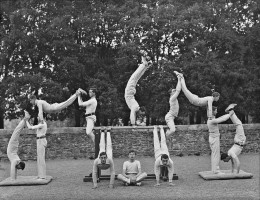
As a K-12 dance specialist, I am required to keep my teaching certificate up to date.
This is done by taking college graduate level courses or other appropriate classes. This semester I am taking two: a literacy course focusing on strategies for differentiated reading and a dance pedagogy course emphasizing dance education as an agency for social change. Although seemingly very different topics, these two classes have shared several elements. Here are a couple of the most influential aspects currently shaping my teaching.
Culturally Responsive Teaching: Knowing and Celebrating the Students Before You
Sometimes as educators we get caught up in the act of teaching and forget the people we are mentoring. Class combinations, technical concepts, and history lessons are important but unless the children you have in your studio have a reason to connect to your material, the extent of your reach will be limited and your influence fleeting.
Consider things like this:
- What makes this student unique? Life experiences, dance experiences, ethnicity, gender, age, family background, community involvement, academic strengths and challenges, languages spoken (and as a dancer, I include movement fluency, too). How do these attributes color how your student will engage with your lesson’s content and style of delivery?
- What does the class community have to gain from this student? How might we learn from each other?
- How might each student’s viewpoint contribute to our group experience? How can we value similarities as well as differences among individuals?
- How might the validation of their experiences and sharing of their perspective encourage students to do more and achieve more?
- Will understanding these aspects to the children in my class shape how I introduce movement ideas, class readings and/or writings, place dance in social and historical perspectives, and challenge their understanding of bodies and movement? If so, how and to what extent?
This can also be referred to as a Constructivist Classroom, where the class community constructs or builds the learning experience.
In this type of environment, the group tends to value:
- All participants contributing to the process and product
- Including and developing each student’s point of view
- Class activities that challenge students’ suppositions about dance, learning, and roles within various environments
- Teachers planning lessons about big concepts that transcend beyond single subject areas
- Responsibility shared by teacher and students in leading learning experiences
- Learning processes that reflect active research and lead to conclusions rather than answers
- The flexibility of lesson plans that can change based on the ongoing work rather than preparing for the test
- The progression of lesson plans that reflect the concrete learning and not strictly the pre-established course goals
- The teacher being viewed as a guide and not necessarily an all-knowing authority
- Teachers posing problems to be solved or investigated rather than delivering information in a more traditional way of delivering information and expecting students to retain it
Viewing dance through a variety of lenses benefits any dance educator but so does viewing students in this way.
The arts are important for the element of humanity that they can bring to the living experience.
This can and should be emphasized in arts education, where our classes are not subject to standardized tests and we have greater flexibility in how we present our discipline. Innately, dance offers students opportunities to express and discipline themselves. Yet examining how we present dance puts us the driving seat for determining the future of our field.
How will you deepen your class experience this week?
Heather Vaughan-Southard MFA, is a choreographer, dance educator, and performer based in Michigan. She currently directs the dance program at the Everett High School Visual and Performing Arts Magnet in Lansing. With the philosophy of teaching dance as a liberal art, Ms. Vaughan-Southard collaborates with numerous arts and education organizations throughout the state. She has danced professionally in Chicago, Detroit, Los Angeles, and New York and has performed works by Mia Michaels, Lar Lubovitch, Donald McKayle, Billy Siegenfeld, Alexandra Beller, Debra Levasseur-Lottman, and Bob Fosse. As a choreographer, her work has been credited by the Los Angeles Times for “creating heat.” She has recently choreographed for the dance programs at Michigan State University, Grand Valley State University, Lansing Community College and is the former dance professor at Albion College. She is a regular guest artist and blogger for Dance in the Annex, an innovative dance community in Grand Rapids. Heather received her MFA in Dance from the University of Michigan, BFA in Dance from Western Michigan University and K-12 certification in Dance from Wayne State University. Read Heather’s posts.

